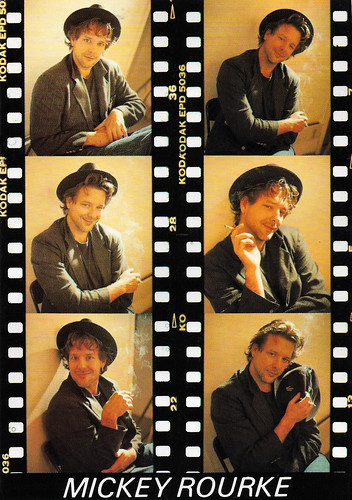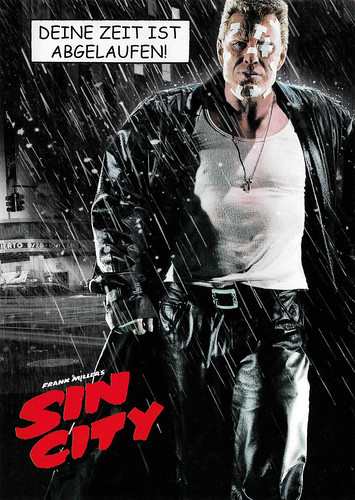
French postcard by Humour a la Carte, Paris, no. ST-186. Photo: TriStar Pictures. Mickey Rourke in Angel Heart (Alan Parker, 1987).

British postcard by Palm Pictures, no. C 7. Mickey Rourke on the set of The Pope of Greenwich Village (Stuart Rosenberg, 1984).

French postcard by Editions F. Nugeron, Paris, no. 2. Photo: Collection de l'École de Cinéma CAMIRIS. Kim Basinger and Mickey Rourke in Nine ½ Weeks (Adrian Lyne, 1986).

French postcard by Editions La Malibran, Paris, in the Collection Cinema Couleur, no MC 32, 1989. Photo: Mickey Rourke in Angel Heart (Alan Parker, 1987).

Vintage postcard by World Postcards Inc., no X 177, 1989. Photo: Mickey Rourke in Homeboy (Michael Seresin, 1988).
A shy and reserved student, but very comfortable with improvisation
Philip Andre 'Mickey' Rourke Jr. was born in Schenectady, New York, in 1952, He was the son of Ann (Cameron) and Philip Andre Rourke, a bodybuilder. He has a brother, Joey, and an older sister, Patricia. The nickname Mickey was given to him as a child by his parents, who thought he looked like a mouse.
When he was six, his parents divorced. A year later, his mother married Eugene Addis, a Miami Beach police officer, and mother and son moved to Miami Shores, Florida. There, he went to the Miami Beach Senior High School. Rourke joined a self-defense course at the Boys Club of Miami. Here he learned to box and began a career as an amateur boxer. At that time, he was more interested in baseball and boxing than in acting.
At the age of 12, he won his first match in the 51-54 kg category. He then called himself Andre Rourke. Later, he moved to a gym on 5th Street in Miami and joined the Police Athletic League. In 1969, he briefly became a sparring partner of Luis Rodriguez, who at that time was the world light heavyweight champion. In 1971, he suffered a concussion during a boxing match, so doctors ordered him to stop boxing for a year.
After working for a short time as a busboy at the famed Forge Restaurant on Miami Beach, Rourke moved back to New York to seek out a career in acting. He attended acting classes at the Lee Strasberg Theatre Institute. Rourke says of himself that he was a shy and reserved student, but very comfortable with improvisation. His teacher Sandra Seacat convinced him to move to Los Angeles.
After a few small roles on television, Rourke made his film debut in the small role of Private Reese in Steven Spielberg's war comedy 1941 (1979). A year later, he appeared in Heaven's Gate (Michael Cimino, 1980), one of the biggest commercial failures in film history that meant the end of United Artists. A year later, he appeared alongside Kathleen Turner and William Hurt as a pyro expert in the thriller Body Heat (Lawrence Kasdan, 1982). This is generally regarded as his breakthrough.

British postcard by Minerva, Holmes McDougall LTD, Edinburgh, no. PC268.

British postcard by Classics Postcards London, no. 59. Matt Dillon and Mickey Rourke in Rumble Fish (Francis Coppola, 1983).

American postcard by Zoetroope Images LTD., Boston, Mass, no. 398. Matt Dillon, Vincent Spano, and Mickey Rourke in Rumble Fish (Francis Coppola, 1983).

French postcard by Ebullitions, no. 544.

French postcard by Amorimage Productions (distribution by Humour a la Carte), no. ST-183. Photos: Frédérique Veysset.
The sensitive and protective older brother of Matt Dillon
In the 1980s, Mickey Rourke began to claim the lead role a little more often. He was one of Steve Guttenberg and Kevin Bacon's young pals in Barry Levinson's Diner (1982). He appeared as the sensitive and protective older brother of Matt Dillon in Francis Ford Coppola's Rumble Fish (1983).
Rourke had his first lead role in The Pope of Greenwich Village (Stuart Rosenberg, 1984), co-starring with Eric Roberts.
He reunited with Michael Cimino for the violent police film Year of the Dragon (1985), based on a scenario by Oliver Stone. Rourke gave a bravura performance as police captain Stanley White, fanatically determined to eliminate John Lone, the crime boss of New York's Chinatown. The film was hotly contested in the United States, however, with critics denouncing the negative portrayal of Chinese people and the overtly racist nature of its central character.
He gained the status of sex symbol with the erotic drama 9½ Weeks (Adrian Lyne, 1986), which became one of Rourke's best-known films. He plays John, a man who starts an affair with Elizabeth (Kim Basinger).
A year later, he played the lead in Angel Heart (Alan Parker, 1987), opposite Robert De Niro. The film was once again controversial in the United States, initially rated X (No one under 17 admitted) because of the sex scene between Rourke and the young Lisa Bonet, fresh off The Cosby Show. The sequence was eventually censored in the cinema and Rated R (Restricted – Under 17 requires accompanying parent or adult guardian).
For his next film, Barfly (Barbet Schroeder, 1987), the actor received rave reviews for his role as the alcoholic writer Henry Chinaski, based on Charles Bukowski. These rebellious anti-hero characters were especially well-liked in Europe and especially France where Rourke was a popular film idol.

French postcard by Humour a la Carte, Paris, no ST-198. Photo: Marianne Rosenstiehl. Mickey Rourke in Year of the Dragon (Michael Cimino, 1985).

Vintage postcard, no. X 142. Photo: Kim Basinger and Mickey Rourke in Nine ½ Weeks (Adrian Lyne, 1986).

British postcard, no. FA 222. Photo: Mickey Rourke in Angel Heart (Alan Parker, 1987).

British postcard by Moviedrome, no. M1. Mickey Rourke in Angel Heart (Alan Parker, 1987).

French postcard by Editions Damilla, Paris, no 94967. Photo: Mickey Rourke in Angel Heart (Alan Parker, 1987).
A near brain-dead prizefighter
Mickey Rourke wrote, produced, and starred in Homeboy (Michael Seresin, 1988), a film about a near brain-dead prizefighter. It skipped theatrical release and went straight to home video.
Rourke joined Walter Hill's Johnny Handsome (1989), then appeared in Wild Orchid (Zalman King, 1989). Divorced from his first wife Debra Feuer in 1989, he met actress-model Carré Otis on the set, who became his wife in 1992. The film was mocked by critics for its overall weakness and its sex scenes considered too explicit, some of which were cut to avoid the film being classified as pornographic.
Rourke played another anti-hero in Desperate Hours (Michael Cimino, 1990) but was nominated for a Razzie Award for Worst Actor of the Year for his performances in Wild Orchid and Desperate Hours. He worked with David Bowie on his album 'Never Let Me Down'', but his film career had taken a turn downhill. Another setback was Harley Davidson and the Marlboro Man (Simon Wincer, 1991), with Don Johnson. Rourke later admitted that he only made the film for the money.
Mickey decided to take up boxing again. He felt that he was self-destructive and had no respect for the actor Rourke. His boxing career did not go smoothly. Under the supervision of his coach, Chuck Zito of the Hells Angels, he was often injured. In retrospect, he would admit that he was too old to return to boxing, but that he had done so anyway for personal reasons.
In 1995, he continued to work on his film career but he had to make do with supporting roles. In 1997, Mickey Rourke appeared on screen with his face surgically altered, his features enlarged and his body thickened in Double Team (Tsui Hark', 1997) opposite Jean-Claude Van Damme. Rourke also reprised his role as an s&m fetishist in Another 9 1/2 Weeks (Anne Goursaud, 1997), a virtual remake of the original, only sans the redeeming presence of Kim Basinger.
He had a small part in Francis Ford Coppola's adaptation of John Grisham's The Rainmaker (1997). There were also quite a few roles that barely came to light. In the critically-worshipped The Thin Red Line (Terrence Malick, 1997), his role was edited out. Unemployed and broke, he had to sell his motorbike collection and his Los Angeles mansion to pay off his creditors and was temporarily committed when his friends became concerned about his suicidal tendencies.
In 1999, he played an important role in the Flemish film Shades (Erik Van Looy, 1999). He also appeared as a transvestite prisoner in Steve Buscemi's Animal Factory (2000), and opposite Sylvester Stallone in Get Carter (Stephen T. Kay, 2000). The latter film, above all, enabled him to straighten out his financial situation, thanks to Stallone.

British postcard by Personality Posters LTD., no PP45.

British postcard, no. FA 223. Mickey Rourke in Angel Heart (Alan Parker, 1987).

French postcard in the Collection Cinéma Couleur by Editions La Malibran, Paris, no. MC 29, 1989. Photo: Mickey Rourke and Faye Dunaway in Barfly (Barbet Schroeder, 1987).

French postcard by Sonis, no. C. 109. Photo: Deal. Mickey Rourke and Carré Otis in Wild Orchid (Zalman King, 1989).

French postcard by Sonis, no. C. 110. Photo: Deal. Mickey Rourke in Wild Orchid (Zalman King, 1989).
An imposing beast of a fellow
Mickey Rourke gave an impressive supporting performance in Sean Penn's police procedural-cum-harrowing study of obsession, The Pledge (2001) opposite Jack Nicholson.
After Rourke played a role in the music video for the song 'Hero' by Enrique Iglesias, he appeared in Roberto Rodriguez's hit Once Upon a Time in Mexico (2003). As a harbinger of things to come, a powerful creative bond formed between the weathered, iconic Rourke and the tireless director on the Mexico set.
In 2005 they again teamed for Rodriguez's and Frank Miller's eagerly anticipated big-screen adaptation of Miller's Sin City comics. Bruce Lawton writes at AllMovie: "Cast as lovelorn brute Marv, Rourke delivered an impressive performance as an imposing beast of a fellow bent on avenging the death of an angelic prostitute in this stylish noir comic book come to life, which gave him cult status among a new generation of fans.
In 2004, Rourke delivered a memorable supporting performance in Tony Scott's Man on Fire (2004) alongside Denzel Washington. It marked the first film in a two-picture creative partnership between Scott and Rourke, the second half of which came to fruition with Domino (2005) starring Keira Knightley.
In 2008, he collaborated with Darren Aronofsky on the film The Wrestler. Rourke was widely praised for his role as Randy "The Ram" Robinson, a wrestler who is way past his prime. Besides the typical elements of a sports drama, the film also contains some striking similarities with Rourke's own career as a boxer and actor. Mickey Rourke won a Golden Globe in 2009 for this role.
Rourke would enjoy sustained success in the years to follow, appearing in films like The Expendables (Sylvester Stallone, 2010), and Iron Man 2 (Jon Favreau, 2010) with Robert Downey Jr. and Scarlett Johansson. The latter brought in more than $312 million in the United States. His later films include Immortals (Tarsem Singh, 2011), the thriller The Courier (Hany Abu-Assad, 2012), and the Western Dead in Tombstone (Roel Reiné, 2013).

British postcard by Heroes, London, no. SPC2228.

French postcard by Editions SPK, Ref. 265.

Italian postcard by World Pictures, no. P.c. 182.

German postcard by Edgar Medien, no. 7.592. Image: Miramax. Photo: Rico Torres. Mickey Rourke in Sin City (Frank Miller, Quentin Tarantino (special guest director), Robert Rodriguez, 2005).

French postcard by Metropolitan. Image: Miramax. Artwork: The Weinstein Company. Mickey Rourke in Sin City - A Dame to Kill For (Frank Miller, Robert Rodriguez, 2014). Captions: He means no harm. But he does cause a lot of harm. Mickey Rourke is Marv.
Sources: Bruce Lawton (AllMovie), Chase Rosenberg (IMDb), Wikipedia (Dutch, French, and English), and IMDb.
No comments:
Post a Comment